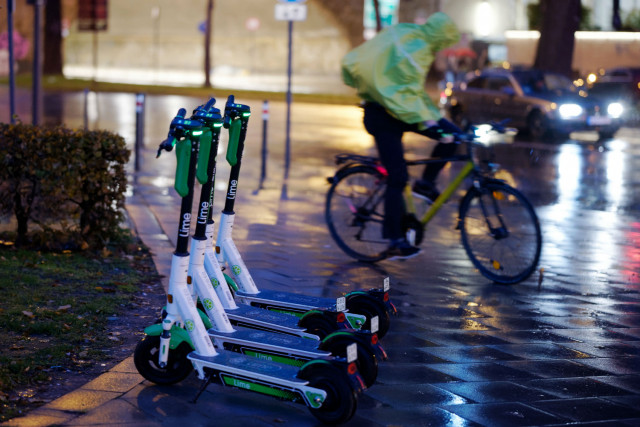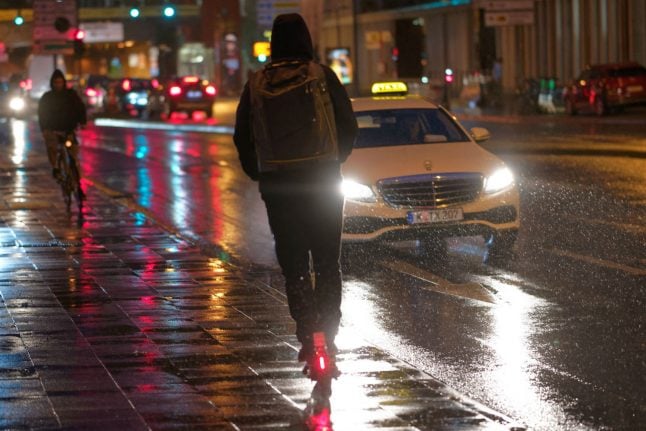Germany is slowly getting used to electric scooters, which were introduced across cities at the beginning of summer.
But now that the weather has changed, some people fear the amount of accidents will increase.
The TÜV (Technical Inspection Agencies) Association recently called on e-scooter suppliers to block the use of their vehicles in winter – or at the very least warn people how to stay safer when using them during cold snaps.
To stop the use of e-scooters, providers would either have to take them off the road or block them on the app.
“When it's very slippery, providers should block their e-scooters immediately to avoid accidents,” said Frank Schneider, mobility expert at TÜV.
We looked at how they might be used – of if they should be – in winter.
READ ALSO: Revealed: What you think of the rise of e-scooters in Germany
Are electric scooters purely a summer pleasure?
On the long, warm days of summer you likely saw them everywhere. Yes, Germany had e-scooter fever as people rode them from A to B, or did a few laps round their neighbourhood.
Yet an increase in accidents and people riding e-scooters while drunk resulted in calls for tighter regulations – and even bans – over fears of ‘chaos'.
But ultimately they were a resounding hit. Even a majority of Local readers – 52 percent – backed the vehicle's arrival in Germany.
So what happens in winter? In principle, the use of electric scooters is possible in the cold season.
“Business continues on a regular basis,” said Bodo Braunmühl from e-scooter rental company Tier. “People still have to move around. And waiting 20 minutes in the cold for a bus isn't nice either.”
It’s only when ice and snow arrive that suppliers will think about limiting or changing their operations.
 E-scooters parked up in Cologne. Photo: DPA
E-scooters parked up in Cologne. Photo: DPA
So how will it work in colder months then?
Since you need an app on your own smartphone to rent an e-scooter, the providers can block this service at short notice.
They can also use the app to define zones where scooters are not allowed to be parked. And it looks like there will be more rules for where people can ride and park the vehicle in winter.
READ ALSO: Parking bans and restricted zones: How German cities plan to crack down on e-scooters
Cologne is planning to expand the prohibition zones for scooters at the start of their Karneval season on November 11th, for example. There may also be restrictions in some cities during the Christmas market season.
Are the vehicles winterproof?
Providers say they can withstand colder weather. However, some companies are working on an even more winter-proof variant, said Tier spokesman Braunmühl. Voi Scooters said that its latest model is equipped with all-weather tyres.
Do the batteries still run in the cold?
Today's lithium-ion batteries have no major problems with temperatures as low as –15C, Lars Zemke from the Bundesverband Elektrokleinstfahrzeuge (Federal Association of Mini Electric Vehicles) said.
Since the battery develops heat while it's running, riding is always the ideal situation for the vehicle in winter. In some cases, however, suppliers assume the battery life will be shorter if temperatures remain below freezing for a long period of time.
Will there be as many scooters on the roads in winter as in summer?
All suppliers want to maintain their operations throughout the year, but there are likely to be fewer scooters on the roads overall. Lime and Voi want to provide approximately the same number of scooters on the German roads as they did in the summer months, while Circ and Tier will have smaller fleets in winter.
READ ALSO: 'Improve cycling infrastructure': Can Germany cope with electric scooters?
But a minimum number of scooters is needed in the cities for the mobile concept to work, says the Tier spokesman. If a user has to walk miles to the next scooter, the business model no longer works.
Who has concerns?
Lots of groups and individuals have reported concerns over the safety of electric scooters since the vehicles were given the green light in Germany.
The TÜV association has urged that customers are at least made aware of the dangers of riding in the cold season. They've suggested that customers should be able to rent helmets along with the e-scooter, for example.
In North Rhine-Westphalia 54 accidents were reported from June up until the end of August, local media said. Cologne is regarded as the accident capital for e-scooters: by mid-October, 83 accidents had happened with 19 seriously injured people.
What can you do yourself?
Be careful – and check before using the scooter if the weather is suitable.
“Particularly in areas with cobblestone pavements,, an increased risk of frost or slipperiness can be expected,” said Zemke of the Bundesverband Elektrokleinstfahrzeuge.
The TÜV also warns users to take care when there's wet leaves on the ground. When days get shorter, it's even more important to pay attention to visibility.
Police recommend: “Bright clothing and preferably a high-visibility vest”. The experts also recommend wearing helmets.



 Please whitelist us to continue reading.
Please whitelist us to continue reading.
52% a majority eh? Not what us remainers would say 😉